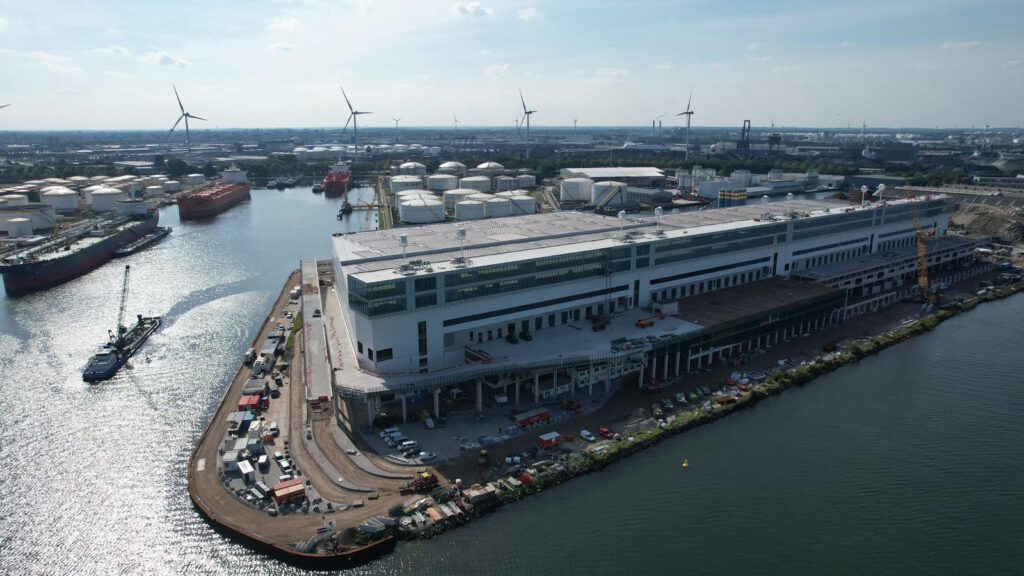City logistics is under attack with more car-free residential areas, congested inner cities, and pedestrianized campuses. In the following years, logistics service providers must deliver more volume with fewer vehicles, safer and cleaner. Logistics service providers should plan city logistics routes carefully, considering local regulations, zero-emission zones, road closures, times windows, loading and unloading points, road safety, and weight restrictions. When can it be done with a large truck or a small van? And when with a cargo bike or even a barge? City logistics today is precision logistics.
City logistics hubs: sharing is caring
City logistics hubs offer a solution where efficient and sustainable bulk deliveries from factories, container terminals, and distribution centers to the region are done with ‘slow mobility’ (and why not by water?) and transferred to just-in-time deliveries that are precisely tailored to the demands of the customer in the city; the consumer, the construction site, the office, the retail store, and HoReCa.
Sharing is caring. Shippers and logistics service providers will work closely in future city logistics hubs. The partners in the city logistics hubs add value in unpacking, installation, returns, stock keeping, the zero-emission ‘last mile’ to the customers, and smart charging. The economy of scale is a prerequisite for successful collaboration.
Traditionally, city logistics was all about ‘stuff’: pallets, barcodes, and vans. The new city logistics requires ‘fluff,’ the smart use of data in collaborative planning and execution. With infrastructural changes in Europe, road pricing, the need to reduce CO2 for the Paris Climate Agreement, and new zero-emission zones, the right hub near the city will be critical for shippers and logistics service providers in city logistics.
Space for city logistics hub is scarce
European cities will grow in the coming decades, both in population and economic activities. Population growth is strongly related to employment growth. Therefore, integrating working and living in cities is vital to remain economically and socially diverse and create local job opportunities for skilled workers.
Unfortunately, space for city logistics is disappearing from European cities due to housing plans in many fast-growing European cities. In addition, the loss of light industrial areas in and around cities leads to major city logistics problems. How will we receive our parcels at home? How will restaurants, cafés, and shops be delivered? And how do we organize circular supply chains?
Companies can look for more space further away from the city. But that does not help the local transport company, catering provider, service engineer, or plumber. This will create all kinds of new problems. Employees must travel to work longer (often by car), and delivery vans must drive further back and forth. That is not good for congestion nor for the CO2 footprint. Moreover, the greater distance to the city is a constraint for clean, light, and electric vehicles.

Value creation: combining stuff and fluff
City logistics traditionally had a large logistics footprint with a low density. The average business park is outdated, energy systems are congested, and many buildings are unsustainable. The strong growth of cities and the energy transition require densification and a reduction of the city logistics footprint. Shippers and logistics service providers should do more in less space. That does not work with ‘business as usual.’ Why are hundreds of wholesale locations for construction and catering, which offer the same products, located around one city? Why don’t companies share their warehouse and transport capacities and their energy? Are there options to develop multi-store logistics operations?
Companies must respond quickly to market, social, and technological changes. Innovation requires new combinations of existing ideas and knowledge, creating value, combining ‘stuff’ and ‘fluff.’ The future economy revolves around the energy transition, the circular economy, industry 4.0, robotization, 3D printing, open innovation, and smart logistics. So should future city logistics.
Cityhubs as ecosystems
The challenge for companies is to develop new business models together. Business models link innovative light industrial manufacturing, logistics, and service processes (stuff) to the smart use of data (fluff). In recent years, cities have focused on developing urban innovation districts around knowledge institutes and business clusters for the development of start-ups and innovative business models. City logistics business parks will become ecosystems where companies will test and improve last-mile technology, services, and business concepts in local living labs and innovation districts.
With the limited space available, this issue of where to locate your last-mile operations can no longer be postponed. So, where will you be located five years from now?
The good news is that there are more and more city logistics initiatives to join, such as CtPark Amsterdam Cityhub and City Logistics Innovation Campus in the Netherlands. One day, we may meet in my beautiful hometown and discuss the great potential for creating value with new city logistics concepts.
Walther Ploos van Amstel
Professor in city logistics
Amsterdam University of Applied Sciences
